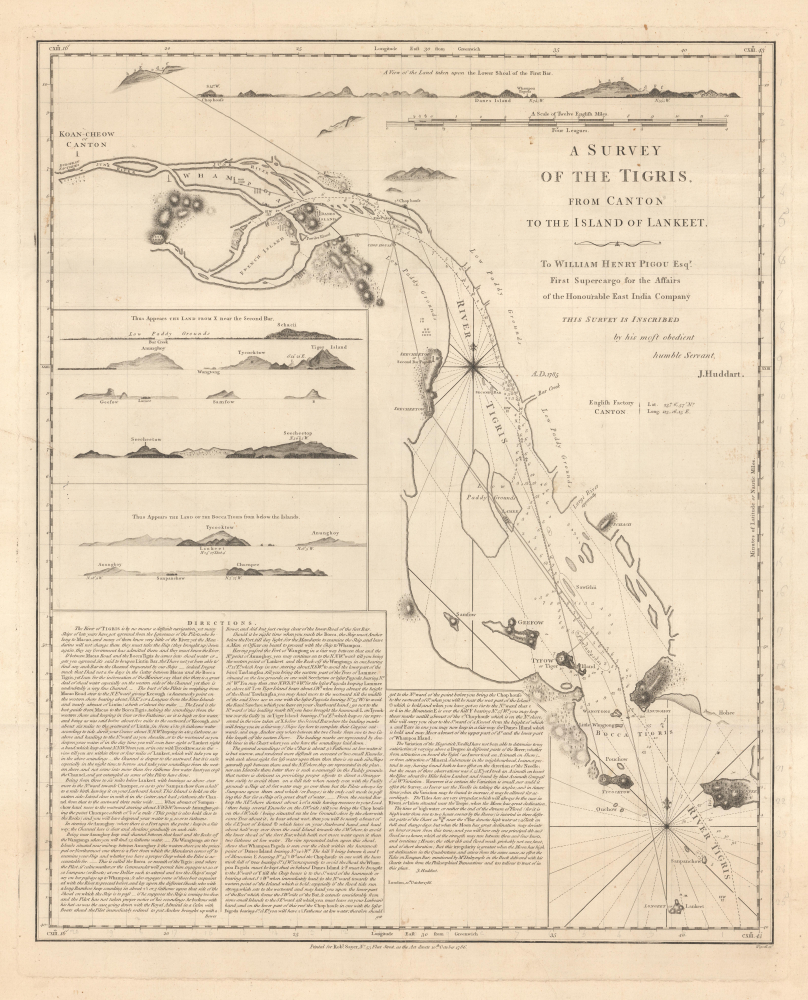Digital Image: 1786 Huddart Map of the Pearl River, China: Hong Kong, Guangzhou
PearlRiver-huddart-1786_d
Title
1786 (dated) 26.25 x 21.25 in (66.675 x 53.975 cm) 1 : 97000
Description
FOR THE ORIGINAL ANTIQUE MAP, WITH HISTORICAL ANALYSIS, CLICK HERE.
Digital Map Information
Geographicus maintains an archive of high-resolution rare map scans. We scan our maps at 300 DPI or higher, with newer images being 600 DPI, (either TIFF or JPEG, depending on when the scan was done) which is most cases in suitable for enlargement and printing.
Delivery
Once you purchase our digital scan service, you will receive a download link via email - usually within seconds. Digital orders are delivered as ZIP files, an industry standard file compression protocol that any computer should be able to unpack. Some of our files are very large, and can take some time to download. Most files are saved into your computer's 'Downloads' folder. All delivery is electronic. No physical product is shipped.
Credit and Scope of Use
You can use your digial image any way you want! Our digital images are unrestricted by copyright and can be used, modified, and published freely. The textual description that accompanies the original antique map is not included in the sale of digital images and remains protected by copyright. That said, we put significant care and effort into scanning and editing these maps, and we’d appreciate a credit when possible. Should you wish to credit us, please use the following credit line:
Courtesy of Geographicus Rare Antique Maps (https://www.geographicus.com).
How Large Can I Print?
In general, at 300 DPI, you should at least be able to double the size of the actual image, more so with our 600 DPI images. So, if the original was 10 x 12 inches, you can print at 20 x 24 inches, without quality loss. If your display requirements can accommodate some loss in image quality, you can make it even larger. That being said, no quality of scan will allow you to blow up at 10 x 12 inch map to wall size without significant quality loss. For more information, it is best consult a printer or reprographics specialist.
Refunds
If the high resolution image you ordered is unavailable, we will fully refund your purchase. Otherwise, digital images scans are a service, not a tangible product, and cannot be returned or refunded once the download link is used.
Cartographer S
Joseph Huddart (January 11, 1741 - August 19, 1816) was a prominent English sea captain, hydrographer, chartmaker, inventor, and entrepreneur. Born into a fishing family in Allonby, near Maryport in Cumberland, he began his career at sea with his father as a fisherman. By 1762, he commanded the sloop Allonby, carrying cured fish to Ireland for the West Indian market. Later, he designed and built the first ship he would own privately, the Patience, launched in 1768 for the West Indies trade. In 1773, Huddart entered the service of the East India Company as Fourth Officer aboard the York, sailing to St. Helena and Bencoolen. During this voyage, he carried out extensive scientific surveys and observations along the western coast of Sumatra. His efforts came to public notice in 1777 when Robert Sayer published Huddart's charts of the Sumatran coastline and commissioned him to survey St. George's Channel, a project completed in the summer of 1778. The resulting chart, noted for its precision, secured his reputation as one of Britain's foremost hydrographers and ensured his financial success. Later, in 1777, he returned to the East India Company, where he rose to the position of Captain of the Royal Admiral. For nearly ten years, he sailed routes between India and China. In 1786, his chart of the Tigris (Pearl River, China) delta was issued by Robert Sayer. Huddart retired from active service in 1791 but continued to play a central role in maritime affairs. That same year, he was elected a Fellow of the Royal Society, and in 1798, he became one of the founding directors of the East India Dock Company, laying its first foundation stone in 1804. He also served for 25 years as one of the Elder Brethren of Trinity House, offering his expertise on harbor and dock improvements. His inventive work included the three-arm protractor used by hydrographers and a system for using high-water marks in the London docks - a method that remained in practice until the 1960s. Perhaps his most significant contribution to the maritime arts was the development of steam-powered machinery for rope-making, which he transformed into a highly profitable enterprise. More by this mapmaker...
Robert Sayer (1725 - January 29, 1794) was an important English map publisher and engraver active from the mid to late 18th century. Sayer was born in Sunderland, England, in 1725. He may have clerked as a young man with the Bank of England, but this is unclear. His brother, James Sayer, married Mary Overton, daughter-in-law of John Overton and widow of Philip Overton. Sayer initially worked under Mary Overton, but by December of 1748 was managing the Overton enterprise and gradually took it over, transitioning the plates to his own name. When Thomas Jefferys went bankrupt in 1766, Sayer offered financial assistance to help him stay in business and, in this way, acquired rights to many of the important Jefferys map plates as well as his unpublished research. From about 1774, he began publishing with his apprentice, John Bennett (fl. 1770 - 1784), as Sayer and Bennett, but the partnership was not formalized until 1777. Bennett retired in 1784 following a mental collapse and the imprint reverted to Robert Sayer. From 1790, Sayer added Robert Laurie and James Whittle to his enterprise, renaming the firm Robert Sayer and Company. Ultimately, Laurie and Whittle partnered to take over his firm. Sayer retired to Bath, where, after a long illness, he died. During most of his career, Sayer was based at 53 Fleet Street, London. His work is particularly significant for its publication of many British maps relating to the American Revolutionary War. Unlike many map makers of his generation, Sayer was a good businessman and left a personal fortune and great estate to his son, James Sayer, who never worked in the publishing business. Learn More...
George Wigzell (1753 - December 12, 1833) was an English engraver active in London in the late 18th and early 19th centuries. Wigzell was born in Greenwich to a poulterer. From 1769, he apprenticed under Joseph Ellis of the Stationer's Guild and joined the Guild in 1776. Wigzell engraved maps for Robert Sayer, Aaron Arrowsmith, John Stephenson, Laurie and Whittle, and others. His son, Thomas Wigzell (1791 - 1873), was also a map engraver. Learn More...

